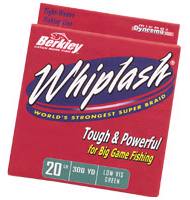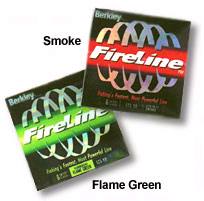**Real Reviews by Real Anglers**
A line which doesn’t stretch and floats without greasing has obvious advantages for run of the mill piking on pits and rivers.
For fishing at long range or drifting, it can literally put more fish on the bank. 
Whiplash is awesome casting kit. In 30lb breaking strain, it has the same diameter as 6lbs mono, adding yards to the most cack-handed chuck.
Low diameter equals lightness, meaning you can mend the line effortlessly even on an 80-yard trot, without dragging the float off course. On stillwaters you can also get away with lighter end tackle, anchoring a laid-on bait with just a couple of swanshot, rather than the half an ounce of lead you need to stop the breeze towing your rig around.
Despite its fine diameter, it knots up well – provided you use the recommended Uni-knot, add a couple of extra turns for good measure and moisten the knot before you carefully pull it tight.
The drawback is this same low diameter also means extremely low abrasion resistance, so this isn’t the one to reach for in snaggy swims. You also have to be careful moving float or rig stops, to avoid nicking it with your fingernails.
To be honest, it looked so fine I didn’t believe it would break at 30lb the first few times I fished with it. In actual fact, I’ve never managed to break it; not even pulling for a break on a snag.
You either haul the snag out, or straighten the trebles, meaning you avoid leaving a tethered bait ready to kill the next pike that comes along.
Fireline has been a cult favourite among lure anglers and big fish pikers for several seasons and it’s easy to see why.
It’s all but indestructible in normal use and will stand up to just about any abuse.
I’ve used it for drifting and whacked the hooks into fish at well over 100 yards.
Its one drawback is that it grates in the rings, which some might find a little alarming.
I seldom use the clutch, preferring to backwind when a fish wants to have its head. Those who rely on the drag should slacken it off to provide an added shock absorber. 
Striking doesn’t need to be anywhere near as hard either. You can drive the hooks home with a steady pull.
Both braids will tangle if they aren’t spooled on right. Whiplash is more prone to wind knots, because of its lightness.
Soaking the spool in a bucket of water and winding it on under tension helps. So does wetting the spool before you make your first few casts.Another safety precaution is to make sure you avoid winding slack onto the reel after casting.
Trap the line with a finger when the end tackle hits the water, close the bail arm by hand and actually hold the line tight against the rod until you’ve reeled in the slack and tightened up.
You won’t see the three or four slacker coils which go on if you just turn the handle to shut the bail arm, but they’ll make their presence felt next cast when a great loop flies up the rod rings and causes a bird’s nest.
While both cost the earth compared to mono – around £ 30 for a 300yd spool – they’ll literally last for years with the minimum of TLC.
Braids are not affected by UV light or rotting and they don’t seem to twist and kink up like monos.
At the end of the season all you have to do is turn it round on the reel and that £ 30 is starting to look like a reasonable investment, compared with the cost of changing mono every few trips.
Tech Spec
Both braids are made from Micro Dyneema













